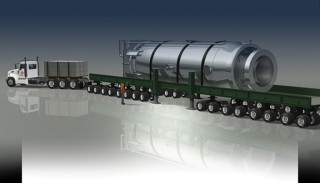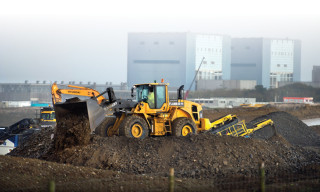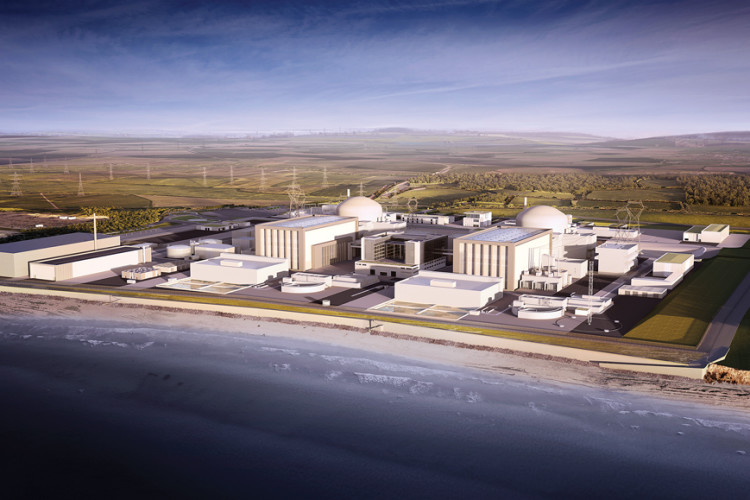The UK construction industry is currently straining at the leash, anxious to get started on two particularly large infrastructure projects: north-south rail link HS2 and Hinkley Point C nuclear power station.
Both are controversial, massively expensive, and will take a long time to complete. HS2 is expected to take a total of 20 years, though Phase One should be complete in eight years. The 3,200MW Hinkley Point C nuclear power station that will supply 7% of UK energy needs is scheduled to complete within 10 years.
But both schemes have resolute government backing. Indeed Hinkley Point C has the backing of both the UK and the French governments, despite widespread and well-publicised opposition.
Warning shots have been fired by several well-informed critics, including Thomas Piquemal, finance director of client Électricité de France (EDF), who resigned after raising concerns that the project could jeopardise the company’s balance sheet. Credit rating agency Moody’s warned that it would downgrade EDF if it went ahead with the project and managers in the French firm sent a letter to board members warning that they could be held personally responsible if their support for it led to a ‘destruction of value’.
Against this background there are two further considerations: the growing argument that large-scale projects of this nature are inherently ‘fragile’ and the evidence that other industrialised nations are moving away from nuclear sources of power towards renewable energy.
Big is fragile, a new paper by Dr Atif Ansar and Professor Bent Flyvbjerg from Oxford University’s Saïd Business School, argues against the political wisdom that big is better and that building capacity ahead of demand is efficient and wise. Ansar and Flyvbjerg argue that oversizing a project increases its complexity and risk, making it much more vulnerable to shocks and uncertainty, and far more difficult to ‘fix’ once broken. Their research develops the concept of the ‘investment fragility threshold’ – the point at which the cumulative losses from an investment exceed the cumulative gains – which, they say, tends to be disproportionately low in monumental projects.
The paper, to be published in Prof Flyvbjerg’s The Oxford Handbook of Megaproject Management, argues that leaders of capital projects must consider where scaling pays off and where it does not.
“Policymakers persist in believing – against all the evidence – that big projects, such as power stations, are not only more efficient but more flexible, as the capacity for expansion is already built-in,” says Dr Ansar. “This means they often lock-in early to a big ‘favourite’ solution, and don’t properly consider other options. The evidence, however, is that the financial, social and environmental performance of big capital investments, in the public and private sectors alike, is strikingly poor.”
But not all big capital investments are alike – there are different asset classes with different risks attached. For example, major dam projects that take eight or 10 years to build are very risky, with cost overruns averaging around 90%; cost overruns on rail project are generally less than half that. But, notes Ansar, big nuclear power stations are the riskiest.
“The average cost overruns have been estimated1 at 207% so Hinkley Point is at a severe disadvantage from the get-go. And if you analyse it using our theories then you can see it is down to the complexities of the project and that projects of this size are only as strong as their weakest link.”
Ansar argues that oversizing a system increases its complexity disproportionately by increasing the number and variety of interactions that are possible among the numerous sub-components. This then causes greater fragility because small errors in one or a few interactions of the bigger system are magnified.
These errors then affect the balance sheet: construction costs overrun; unforeseen and significant expenses are incurred to remedy weaknesses that become apparent as the system ages; and enormous clean-up costs are incurred if the system has to be decommissioned or if it collapses.
And Hinkley Point C is a very large project – one of the biggest of its kind ever attempted by any measure, whether construction time, resources employed or number of components. EDF’s own experience clearly illustrates some of the dangers inherent in megaprojects, the company having run into a slew of problems at two of its current projects at Flamanville in Normandy and Olkiluoto 3 (OL3) in Finland.
OL3 uses the same European Pressurised Reactor (EPR) design as Hinkley Point C. It was scheduled to come online in 2010, but its earliest deadline is now 2018. There are two similar reactors being built in China that are also behind schedule and no other plants have been ordered. Last year EDF was also forced to suspend operations at Heysham 1 and Hartlepool nuclear power stations because of potential technical faults.

But, most crucially for Ansar, the Hinkley Point project is bespoke, a one-off that epitomises the major confusion between “big” and “scaleable”. Economies of scale do not come from big projects, he argues, but from scaleable projects that use standardised, easily replicated components to produce larger systems from repeated patterns of construction. As an example he cites large internet companies such as Amazon, Facebook, and Google which create massive data centres by linking up identical servers, not by designing each one from scratch.
Such an approach might also benefit not just the nuclear industry but also construction too, by breaking down the massive budget into smaller, discrete schemes that could be parceled out to several contractors rather than the ‘winner takes all’ situation that prevails at present. It could also circumvent the politically embarrassing fact that, as part of the price to be paid for Chinese investment, most high-value manufacturing associated with Hinkley Point C will take place in China rather than the UK.
The capacity of the UK to build its own nuclear power stations was diminished when British Nuclear Fuels (BNFL) sold Westinghouse, its US-based construction unit, to Toshiba in 2006. But the UK does still manufacture Small Modular Reactors, or SMRs. These appear to possess all of Ansar’s criteria for success, being small, easily manufactured units that can be configured to form larger single units.
SMRs can produce anything from about 50 to 400 megawatts of electricity, so they would be dwarfed by the output of either of the two 1,600MW reactors planned for Hinkley Point. But they can be manufactured in bulk in a factory before being taken to site by truck, train or barge and set up. Rolls-Royce, which makes nuclear reactors for submarines, is designing a 220MW SMR that measures just 16m in height and 4m in diameter.
An SMR also starts earning money and producing electricity far more quickly than a conventional nuclear power station, which can take 10 years or more before it can be commissioned. By contrast, an SMR can be up and running within three to five years of being ordered.

Another plus is that the smaller reactors require far less water for cooling than conventional reactors, so they do not need to be by rivers, lakes or the coast and can be sited nearer where they are needed. This is an important consideration because a great deal of electricity is actually lost in the distribution network. The World Bank estimates the UK loses around 8% of the energy it generates – twice the figure for Germany, South Korea or Israel and slightly higher than the USA, France or Italy.
But small reactors face some of the same problems facing larger units. Safety, for example. And not many cities would welcome a nuclear reactor, however small. For its part the nuclear industry sees the SMR as an adjunct to developments such as Hinkley Point C. The Energy Technologies Institute (ETI), a partnership between global energy and engineering companies and the UK government, concluded that: “Large reactors are best suited for baseload electricity production…. SMRs could fulfil an additional role in a UK low carbon energy system by delivering combined heat and power (CHP).”

Of course, nuclear power has always been controversial and, helped in part by concerns raised after the Fukushima incident following the Japanese earthquake five years ago, there are signs that other major economies are choosing renewable energy rather than the nuclear option. In Germany, nuclear power is being phased out so that it now only contributes 6% of electricity compared to 23% in 2011. Siemens, which built all of Germany’s reactors, has withdrawn from the market.
The US still has a buoyant nuclear industry with companies such as NuScale and Westinghouse also developing SMR technology. But president Barack Obama has called for the US to secure 25% of its electricity from clean, renewable resources by 2025, supported by US$4.5bn of funding for Smart Grid development, deployment, and worker training. The Smart Grid uses digital technology so there can be two-way communication between the utility and its customers, and sensing along the transmission lines. This greater degree of control enables electricity suppliers to cope with the variability of supplies from wind and solar resources, so they can store the electricity when there is a surplus and reduce demand when the supply dips.
This might seem idealistic but no less a player than IBM has entered the market, arguing that the energy sector is about to be transformed by technology and that the long- term move is towards all electricity – 100% – to be generated from renewable sources. At a recent conference it introduced an initiative called Opus: a ‘framework to optimally plan and orchestrate energy systems of the future’ to integrate renewable energy sources with power stations, or ‘ageing assets’ as it terms them.
Against this background it seems plain that tempting though Hinkley Point C might seem in terms of jobs and investment, it raises serious and substantial issues that have yet to be tackled.
HS2 "not as risky"
The £50bn HS2 project is another troubled megaproject that has been beset with a long list of woes and attracted dedicated opposition from a remarkable range of sources.
But, according to Dr Atif Ansar of the Saïd Business School, it is not nearly as risky as Hinkley Point C because the cost overruns are unlikely to be of the same order.
“Big railways, as an asset class, tend to have cost overruns on average of around 45%. HS2 is a risky project with a lot of uncertainty but, if it goes wrong, it won’t drown the UK economically. Instead it will cost us more than we budgeted for but that won’t be catastrophic,” he says.
The challenge for HS2 will be to introduce the concept of modularity, so that the same components and designs are re-used throughout the project and can also be employed in other projects.
“For instance, can HS2 design one station or interchange that can be replicated over and over again instead of designing each individually?” he asks.
“Madrid Metro certainly did that. They designed one station that was copied down to the last bolt and that resulted in massive cost savings,” he notes. “The Jubilee line cost ten times as much to build per kilometre.”
Modularity alone will not solve all the issues associated with large infrastructure projects but, says Ansar, design can alleviate many of the issues and unexpected delays that can arise when each element is bespoke. This is because everything has been tried and tested in advance.
And, for HS2, the problems keep cropping up. In March Professor Peter Woodward, a reader in railways and geotechnical engineering at Heriot-Watt University, found that the 225mph line speed proposed proposed for HS2 – faster than any other high-speed line in the world – would create “critical track velocity effects” and “significant issues” with track instability.
He said that the ballasted track of the kind to be used by HS2 “may not be able to adequately retain the track geometry” and that “embankment instability, particularly over poor soils … will generate significant issues during construction and operational running”. Roughly a third of the route, 107 miles, will run on embankments. There are two potential answers, both of which would erode the project’s benefit-cost ratio. The first is to run slower trains, adopting the industry standard of 186mph, so that the London-Birmingham journey time would only be 15 minutes faster and the benefit-cost ratio would be 15 per cent less. The second is to stiffen the ground by laying the track on a concrete slab, which would be more expensive and would make the trains noisier.
In the meantime the National Audit Office has started its third report on HS2.
Footnote:
1. Based on Schlissel and Biewald's 2008 review of the US Congressional Budget Office (CBO) data from Energy Information Administration
Got a story? Email news@theconstructionindex.co.uk



